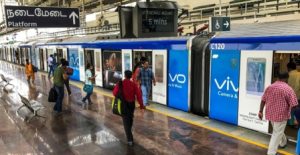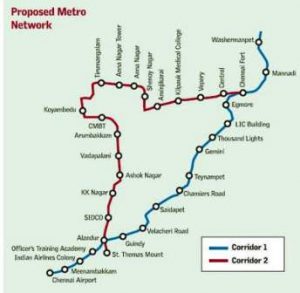Chennai Metro: How soon it would become a white elephant?
The question on white elephant would be decided once the Chennai Unified Metropolitan Transport Authority (CUMTA) fare structure is announced in the near future.
 Chennai’s sub-urban and local train network has a long history. It is quite unique to have all three types of service, that is, surface, underground and elevated structures in its possession. However, the second big investment in early 1990s – the Mass Rapid Transit System (MRTS) – became a white elephant and is one till date.
Chennai’s sub-urban and local train network has a long history. It is quite unique to have all three types of service, that is, surface, underground and elevated structures in its possession. However, the second big investment in early 1990s – the Mass Rapid Transit System (MRTS) – became a white elephant and is one till date.
The Tambaram-Beach Electric Mobility Unit (EMU) services were launched in 1950s is one of the lifelines of the public transport system next to Metropolitan Bus Transport (MTC services) funded by the state government of Tamil Nadu.
The recent sensation, the Chennai Metro operated by the Chennai Metro Rail Limited, now covers a sizeable distance. The recent full-fledged service of the Blue Line in its free ride for four days attracted a footfall of 7.5 lakh. The administrative body of the Metro now claims that both the Green line and Blue Line together attract 1 lakh footfall on an average per day. It is neither be challenged nor to be accepted because the truth is in between the extreme claims.
Because of the stretch that it covers and the fares, the footfall has not been substantial as was expected in the last decade when the project was commenced. The second phase of the Metro is being mooted and expected to operate within the next decade.
“Chennai’s cheapest mode of transport is the EMU which charges a maximum of Rs 30 till the terminus and a minimum of Rs 5. There is a plan to hike the fares. The southern Railway runs the show with heavy subsidy.”
However, the MRTS could not be successful since its fare and route does not attract the public. It was constructed with about Rs. 2,000 to 4,000 crore in the mid 1990s. The only crowd pulling route is Beach to Velachery, which connects OMR with Northern Chennai. Now work has started to connect the route up to North-Western industrial area of Ambattur to leverage more patronage.
Also read: IPTs in an Integrated Urban Transport System
The MTC carries about 30 lakh passengers on any average day but has lost patronage due to sharp fare hikes, two years ago. Though it commands a high level of patronage, it is not a profitable venture either. The sole attraction for a passenger is Rs.1,000 valued monthly unlimited travel pass (not valid in A/C buses) which accrues assured advanced revenue to the Corporation.
Chennai Metro, the future white elephant?
When Metro work was started, there were speculations that it may not suit to tame the road traffic. Obviously, two high roads, Poovirunthavalli (rechristened as Poonamallee) and Anna Salai (Mount Road) where the current green and blue lines are plying had seen many changes and improvements in the past decade. It has an impact on the patronage since profile of in between areas had also seen changes in industry, office and business ventures. While most of these areas had upward mobility, the new affluent would prefer to use individual vehicles rather than use stylish high-end Metro. Remember, Metro was brought into contain vehicular traffic and pollution. Secondly, the fare structure keeps away the middle class who are the next-in-line patrons. Spending Rs.2,000 to Rs.3,000 per month for transport is not at all affordable to a middle class since working persons within a household would be 3-4 by an average.
Compared to other Metros of Delhi, Kolkata, Bengaluru, Chennai Metro is costlier. Because Delhi Metro is covering high network along with Mumbai and Kolkata respectively with 3,27, 313 and 140 kms, Chennai Metro and Bengaluru operate with about 40 kms but have a fare structure equal to the Northern Metros.
“Across India, the minimum fare starts with Rs.10 and the maximum with Rs.60 with few exceptions of special and fare concessions on certain occasions.”
 Kolkata which had the privilege of introducing the Metro in the country operates about 140 kms but the fare structure is minimum of Rs.5 and maximum of Rs.25 but Chennai Metro charges Rs.10 to Rs.60. But Bengaluru charges a maximum of Rs.45 while Delhi and Mumbai have Rs.60 and Rs.40 as the maximum fares. Like other Metros, Chennai Metro is providing unlimited day long pass available for Rs 100 which is yet to become popular.
Kolkata which had the privilege of introducing the Metro in the country operates about 140 kms but the fare structure is minimum of Rs.5 and maximum of Rs.25 but Chennai Metro charges Rs.10 to Rs.60. But Bengaluru charges a maximum of Rs.45 while Delhi and Mumbai have Rs.60 and Rs.40 as the maximum fares. Like other Metros, Chennai Metro is providing unlimited day long pass available for Rs 100 which is yet to become popular.
The CUMTA effort
Recently the state government has notified a unified transport authority for the city to enjoy a hassle-free transit. A decade-old initiative, the Chennai Unified Metropolitan Transport Authority (CUMTA) which was under cold storage came into life due to full operation of two Metro lines. However, the fare structure has not been released.
Also read: Ethanol: A pathway for cost-cutting in state transport corporations
“Since as an everyday commuter, one could easily calculate the fare from their residence to office and back which may burn their pocket as per the current fare structure, the CUMTA is expected to have an affordable fare structure ranging from Rs.1000 to Rs.2000 applicable through a unified ID to have a seamless travel.”
In short, if the fare structure for an unlimited monthly travel per adult becomes Rs.1,500 including last mile connectivity, it would without doubt enjoy a patronage of a million excluding tourists and other travellers. This will fetch minimum of Rs.150 crore for the CUMTA every month. Taking into account, the rising vehicular population and other social costs involved, this fare structure would ease the roads and minds of the public. Any fare structure beyond this ideal line would collapse the very idea of cost-effective, congestion-less public transport in the Metropolitan City.
There are plans to integrate the EMU and MRTS systems into single Metro administration which is ideal. It will improve the operational efficiency and lead to a highly integrated transport system. Along with MTC, the system would be a fair and convenient public transport system. In the revenue end, the two transport entities shall get advanced, affordable and assured returns over their capital investment through fixed monthly pass offer. So, the question on white elephant would be decided once the CUMTA fare structure is announced in the near future.
